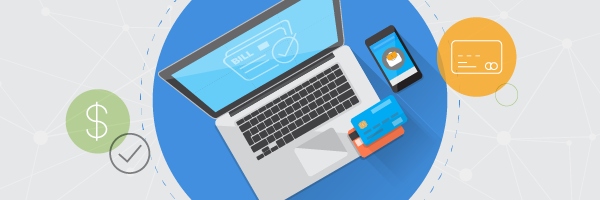Billing and Payments
Credit Cards 101: How Money Gets from a Client’s Card into Your Bank Account

For many business owners, credit card processing is a hidden industry—hidden in plain sight, that is. Today we’re all familiar with using the Visa and MasterCard network as consumers, and we have high confidence that the system will work. We now pay the majority of our bills electronically, from swiping cards at the grocery store, to paying electric bills over the phone, and even scheduling rent and mortgage payments online.
But accepting credit cards as a business owner may spur you to want to know more about the hidden logistics of card payments. In this post, we’ll demystify this process to give you a firm understanding of what happens behind the scenes from the moment a client pays your bill with a credit or debit card to the moment you see funds appear in your bank account.
A brief history of credit cards
Let’s start with a story about how the electronic payment industry we know and use today came into existence. It all started when a diner at a New York restaurant forgot his wallet in 1950, an incident that gave way to the first credit card—Diners Club. Over two years, the Diners Club subscription base quickly grew to 20,000 account holders. Visa and MasterCard took this original idea and expanded on it to create the networks we know and use today.
We refer to Visa and MasterCard as the original card brands, and we call them bank cards because they’re issued by banks. Visa and MasterCard created a computer network as a way for banks to share information about cardholders and business owners electronically—and to move money. It may shock you to know Visa and MasterCard actually started out as associations and their members were banks. Today both companies have gone through public IPOs and their business structures are now decidedly for-profit.
Most of us are familiar with issuing banks because we’re Visa and MasterCard cardholders, and we get these cards through banks. The average consumer now carries two or more credit cards in their wallet, and most millennials don’t carry or have a need for checkbooks.
Now let’s look at what goes on behind the scenes every time someone processes a credit card transaction.
Issuing banks versus acquiring banks
For every transaction completed on the Visa/MasterCard network, there are two banks involved: the issuing bank and the acquiring bank. The issuing bank works with the cardholder—your client, for example. As a cardholder, your client has an agreement with her issuing bank that when she pays your bill with a credit card, she’s going to pay the bank back. The bank is responsible for collecting those funds from her.
The acquiring bank has a relationship with the business owner, or in this example, your CPA firm. The acquiring bank issues you a merchant account, which gives your firm the ability to accept both credit and debit cards for payment at your place of business. The agreement you have with the acquiring bank is that you will provide goods or services in exchange for the money you’re paid, and in exchange, you gain access to the Visa/MasterCard network.
The acquiring bank issues you a merchant account number, which is a unique identifier that lets banks and payment solution companies like CPACharge know which transactions belong to your business.
Three steps of a credit card transaction
A credit card transaction goes through three distinct steps before the funds are paid out to your business bank account: authorization, clearing, and settlement. Let’s look at these steps in greater detail.
1. Authorization
The first step, authorization, is initiated when you or your client swipes, inserts, or manually keys in a credit card for payment. Your payment platform dials out through the Visa/MasterCard network to connect to the issuing bank and find out if the cardholder (your client) has the necessary funds available.
The issuing bank then generates an approval code, which places the funds on hold for your business. Today, this authorization normally takes about two seconds, and the hold is good for 7 to 30 days. A receipt is generated for your client notifying her that the payment has been authorized.

2. Clearing
The clearing step is basically a reconciliation or validation step between the card brands and the banks. For professional services firms like yours, this step typically happens behind the scenes, with your payment processing company sending your transactions on your behalf to the card brands for validation. A batch of all Visa transactions is sent to Visa, and MasterCard transactions are sent to MasterCard.
The card brands then send a reconciliation report to both the acquiring bank and the issuing bank letting them know the transactions have been validated and will be processed. Once this clearing record has been received, it’s time for the acquiring bank to move money.

3. Settlement
The final step, called settlement, normally takes 1–2 business days. In this step, the acquiring bank is responsible for placing funds in your business bank account, according to the agreed-upon amount tied to the approval code that was issued in the authorization step.
Next, the acquiring bank follows up with the issuing bank to be reimbursed for the funds that were deposited into your bank account. The issuing bank is then responsible for posting the sale to your client’s credit line, or collecting the funds from your client’s checking account in the case of a debit card.

There you have it. Now you understand the apparent “magic” that happens each time a client pays by credit or debit. The best part is, with a great payment solution, you don’t need to worry about these logistics, and what appears to happen magically is systematic and automated, so you can focus on running your business.
To learn more about the online payment solution designed specifically for CPA firms like yours, download the CPACharge Solution Guide.


